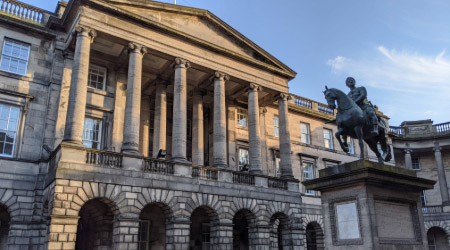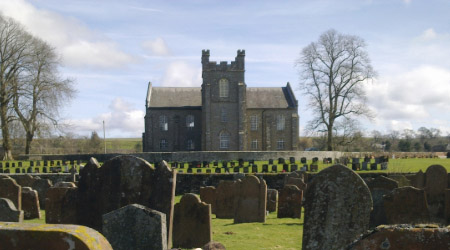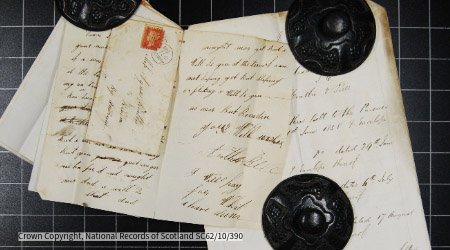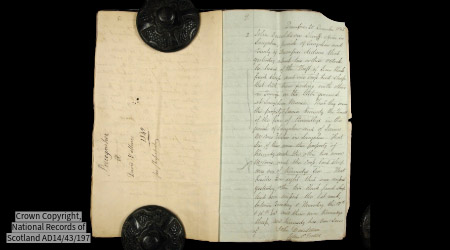Learning Zone - Research Techniques
When there is no father’s name! What can you do?
Discovering more than your ancestor’s name, age and birthplace
Five Ways to Save ScotlandsPeople Credits
When there is no father’s name! What can you do?
It can be very frustrating when a Scottish birth certificate does not name the father. If the parents of a child were not married a father’s name would only be recorded if he presented himself to sign the register when the birth was registered or a court action led to his name being added.
After 1855 it’s important to remember that there are baptism registers. We don’t use them in Scotland much because the post-1855 civil birth registers are so detailed, fully indexed and available online.
The church, however, was not bound by the same rules as the registrar when it came to recording parents’ names. As you can see in this example, it’s a baptism register which gives us the breakthrough we need.
Discovering more than your ancestor’s name, age and birthplace
To research your family tree you need to start by talking to family members and looking at birth, marriage, death and census records. This will give you a basic tree but do you want to find out more?
In this video genealogist Emma Maxwell shows one way to dig further into your family history. Emma shows how she uses newspapers, court indexes and original records to piece the family story together.
Using Wildcards
Finding ancestors is a challenge when there are spelling variants and transcription errors. Wildcards will help you find those elusive ancestors in seconds.
This tip works on our website but will also work on many family history websites.
Five Ways to Save ScotlandsPeople Credits
Only ScotlandsPeople gives online access to civil registration, Church of Scotland parish records and Scottish census record images. We all know how important it is to view these original documents to make sure our research is accurate but the costs can soon mount up if we keep viewing the wrong records. Here are five tips to help you pick the right record the first time.
1 - Post-1855 Death Records
Cross-reference death records using a woman’s maiden surname. In Scotland deaths of married women are indexed under all the names she used during her lifetime (or at least all the names the person registering the death knew about). Let’s say your ancestor was born Janet Porteous and she went on to marry a Thomson. There will be a lot of Janet Thomsons, so use the surname Porteous to narrow down your search. On the search page look out for ‘Other surname’. It doesn’t matter which way round you put the surnames, put Thomson in one and Porteous in the other and it will narrow down your search.
2 - Birth Records from 1855 to 1874
The International Genealogical Index (IGI) includes most Scottish civil registration births from 1855 to 1874. Unlike the index on ScotlandsPeople, the IGI includes the names of both parents. This enables you to narrow down your search then view only the correct entry on ScotlandsPeople. This index is available on Ancestry, Findmypast and FamilySearch.
3 - Census Records 1841 to 1901
Use an index to the 1841-1901 census you already have access to. FreeCen gives access to a free indexed transcription of many Scottish census records from 1841 to 1901 (it is particularly for the earlier years) and it’s a great way to find the right household. Then you can simply go to ScotlandsPeople to view the original. You may also have access to the 1841-1901 census as part of your Findmypast or Ancestry subscription or you may have free access through your local library.
4 - 1911 and 1921 Censuses
As only ScotlandsPeople gives access to the 1911 and 1921 censuses for the whole of Scotland we need to be a bit more savvy. Use the reference to group family members together. Let’s say I am looking for a ‘Scott’ family in the parish of Annan. I will see a lot of entries, for example there are four Agnes Scotts in the parish of Annan in 1911. In the free index on ScotlandsPeople I am also given the reference (‘Ref’), which is key. I can see, for example, that there is an Agnes Scott aged 48 with the reference ‘812/ 5/ 10’ and another Agnes Scott aged 49 with the reference ‘812/ 2/ 10’. Let’s break the reference down, 812 is the parish number for Annan. 812/2 means enumeration book two in the parish of Annan and the 10 at the end is the page number. This means that I know these two Agnes Scotts are not in the same household. Looking through the other ‘Scott’ entries for Annan I see that there are the following entries with the reference: 812/ 2/ 10. I can see James Scott aged 51, Robert Scott aged 20 and George Scott aged 17. Now I have a family group, this should be enough to tell me I have the right family or, in fact, that it’s the wrong family and I don’t need to waste my credits.
5 - Church of Scotland pre-1855 Births and Marriages
Although the images are not available, indexes to the Church of Scotland pre-1855 births and marriages found within the Old Parish Registers (OPRs) are available in various places. As with the 1855 to 1874 civil registration birth records, you can find indexes available on Ancestry, Findmypast and FamilySearch, entitled ‘Scottish Church Records’. Again a feature is that you can search by parents’ names. At first glance this feature is not available on ScotlandsPeople but it actually is! Enter your search criteria and click search in the usual way. When your results appear you will see new search options. You can now add ‘1st Parent Name’ and ‘2nd Parent Name’, this enables you to narrow down your search. I like to search by the surname of the child and the full name of the parents, which shows all children born to that couple.




